



Table of Contents
- Introduction
- Understanding Your Space
- Designing Your Garden
- Plant Selection
- Creating a Comfortable Ambiance
- Maintenance Tips
- Enhancing the Experience
- Conclusion
- Faq's
Balcony gardens are a wonderful way to bring nature into your home, especially in urban settings where space is often limited. Here's an in-depth guide on how to transform your small balcony into a vibrant, functional, and relaxing green oasis.
Introduction
In the bustling urban landscapes of India, the concept of balcony gardens has seen a remarkable rise in popularity. These small but significant patches of greenery offer much-needed respite from the chaotic city life, providing a serene space to relax and rejuvenate. They are not just a trend but a growing necessity, as they play a crucial role in improving air quality by filtering pollutants and increasing oxygen levels. The aesthetic appeal of a well-designed balcony garden adds immense value to apartments, making them more inviting and visually appealing.
Urban living often comes with space constraints, but a small balcony garden can effectively maximize the available area, transforming it into a green haven. Whether you have a compact balcony in a high-rise building or a more spacious one in a low-rise apartment, the possibilities for creating a beautiful garden are endless. With a bit of creativity and strategic planning, you can cultivate a variety of plants, from flowering species and herbs to vegetables and succulents, right in the heart of your home.
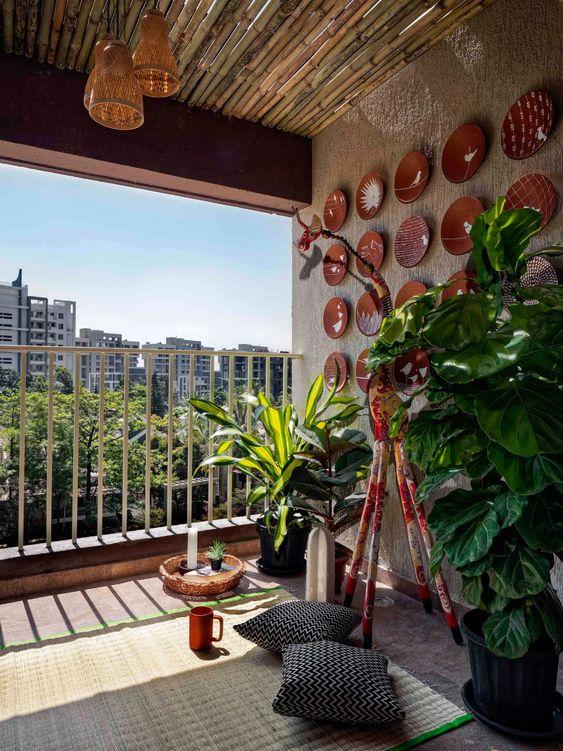 Balcony Garden
Balcony Garden
Image Source: Pinterest
Balcony gardens also offer an excellent opportunity to incorporate sustainable practices into daily life. Using recycled materials for planters, implementing water-saving irrigation systems, and growing your organic produce are just a few ways to make your garden eco-friendly. These small steps not only contribute to environmental conservation but also promote a healthier lifestyle.
Moreover, balcony gardens can be tailored to reflect personal tastes and cultural elements, making them unique expressions of individual creativity. Whether you prefer a minimalist setup with clean lines and few plants or a vibrant, lush space filled with a variety of flora, your balcony garden can be a true reflection of your personality and style.
The benefits of having a balcony garden extend beyond aesthetics and environmental impact. They provide a therapeutic escape, offering a sense of accomplishment and peace to those who tend to them. Engaging in gardening activities can be a great stress reliever and a rewarding hobby, allowing you to connect with nature even in an urban setting.
Understanding Your Space
Creating an effective and beautiful balcony garden starts with understanding your space. This involves evaluating the sunlight and wind patterns and accurately measuring and planning the layout.
Evaluating Sunlight and Wind Patterns
Sunlight:
- Full Sun: If your balcony receives more than six hours of direct sunlight per day, it is considered to be in full sun. This is ideal for growing sun-loving plants such as tomatoes, peppers, and most flowering plants like marigolds and petunias. These plants thrive with plenty of sunlight and tend to bloom profusely.
- Partial Shade: A balcony that gets about 3-6 hours of direct sunlight per day is in partial shade. This environment is suitable for plants like ferns, hostas, and begonias, which require some sunlight but also benefit from periods of shade. Partial shade conditions are great for growing herbs like basil and cilantro, which prefer a mix of sun and shade.
- Full Shade: If your balcony receives less than 3 hours of direct sunlight per day, it is in full shade. This is a challenging condition but perfect for shade-tolerant plants like ferns, peace lilies, and some types of mosses. Full-shade environments can also support leafy greens like lettuce and spinach, which do not require much sunlight.
Wind:
- High-Rise Buildings: In high-rise apartments, balconies often experience strong winds that can damage delicate plants. To counter this, choose hardy plants that can withstand wind, such as succulents, grasses, and certain herbs like rosemary. These plants have sturdy structures that make them more resistant to wind damage.
- Windbreaks: Implementing windbreaks can protect your plants from strong gusts. Mesh screens are effective as they reduce wind speed while allowing some airflow. Tall plants like bamboo or hardy shrubs can also serve as natural windbreaks, providing shelter for more delicate plants.
Space Measurement and Planning
Measuring Your Balcony:
- Accurate Dimensions: Start by measuring the length, width, and height of your balcony. Knowing the exact dimensions will help you plan the layout effectively. Use a measuring tape to get precise measurements of all sides and corners. Consider any obstructions such as railings or air conditioning units that might impact your layout.
- Zoning: Divide your balcony into zones based on the measurements. For example, designate areas for seating, plant placement, and decorative elements. This zoning helps in organizing the space and making the most of every inch available.
Planning the Layout:
- Multipurpose Furniture: To maximize the functionality of your balcony, opt for multipurpose furniture. Foldable chairs and tables can be easily stored away when not in use, freeing up space for other activities. Benches with built-in storage can provide seating while also offering space to store gardening tools and supplies.
- Compact and Lightweight: Choose furniture that is compact and lightweight, making it easy to move and rearrange. Furniture that can be easily stacked or folded can help in creating more space when needed.
- Vertical and Layered Planting: Utilize vertical space by incorporating shelves, hanging planters, and wall-mounted pots. This not only saves floor space but also creates a visually appealing vertical garden. Layering plants at different heights can add depth and interest to your garden.
Creative Solutions:
- Custom-Built Furniture: Consider custom-built furniture tailored to fit the specific dimensions of your balcony. Built-in seating or custom shelves can make efficient use of awkward corners and maximize space.
- Mobile Planters: Use planters with wheels to easily move plants around based on their sunlight needs. This flexibility allows you to adjust your garden setup according to changing seasons and sunlight patterns.
Designing Your Garden
Creating a balcony garden involves careful planning and design to make the most of the available space while ensuring it remains aesthetically pleasing and functional. Here are detailed suggestions on how to design your garden using various techniques and elements:
Vertical Gardening
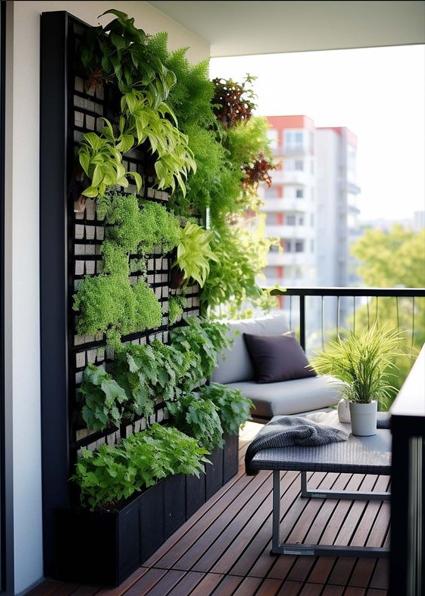 Vertical Gardening
Vertical Gardening
Image Source: Pinterest
Hanging Planters:
- Utilize Wall Space: Hanging planters are a fantastic way to use vertical space, especially when floor space is limited. You can install hooks or brackets on walls or balcony railings to hang these planters.
- Ideal Plants: These planters are great for growing herbs like basil, mint, and parsley, which thrive in small pots. Small flowers such as petunias, pansies, and marigolds also do well in hanging planters. For vegetables, consider compact varieties like cherry tomatoes or small peppers.
Trellises and Green Walls:
- Climbing Plants: Trellises and green walls are perfect for supporting climbing plants, which can create a lush, green backdrop. Plants like ivy, jasmine, and money plants (pothos) are ideal choices as they are hardy and grow quickly.
- Installation: Trellises can be attached to walls or balcony railings, and green walls can be created using modular panels that hold multiple small pots. These installations not only save space but also add vertical greenery to your balcony, enhancing its visual appeal.
Container Gardening
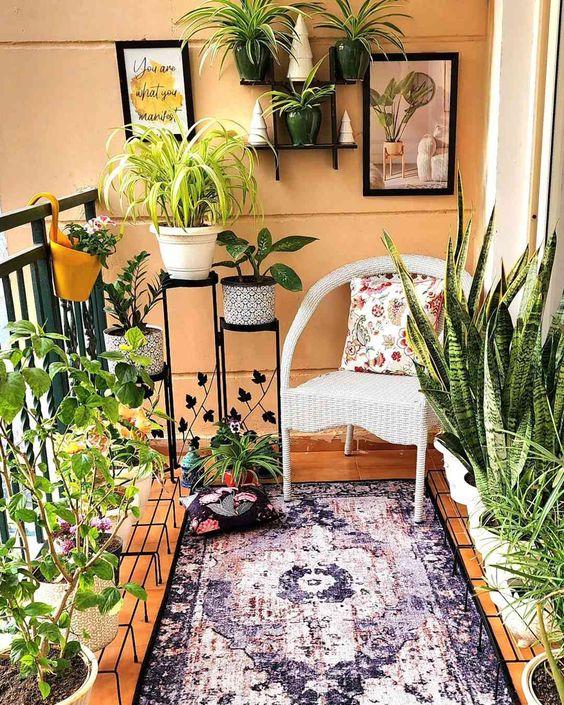 Container Gardening
Container Gardening
Image Source: Pinterest
Terracotta and Ceramic Pots:
- Durability and Aesthetics: Terracotta and ceramic pots are favored for their durability and classic look. These pots are porous, allowing air and moisture to penetrate, which is beneficial for plant roots.
- Variety: Use a mix of pot sizes and shapes to create visual interest. Larger pots can hold bigger plants or small trees, while smaller ones are perfect for herbs and flowers. Grouping pots of different sizes can create a dynamic and layered garden look.
Self-Watering Pots:
- Convenience: Self-watering pots are ideal for busy urbanites who may not have time to water their plants regularly. These pots have a reservoir at the bottom that stores water and allows the plant to absorb it as needed.
- Consistent Moisture: They ensure plants receive a consistent moisture supply, which is crucial for healthy growth. These pots are especially useful for plants that require steady watering, such as herbs and leafy greens.
Compact Furniture
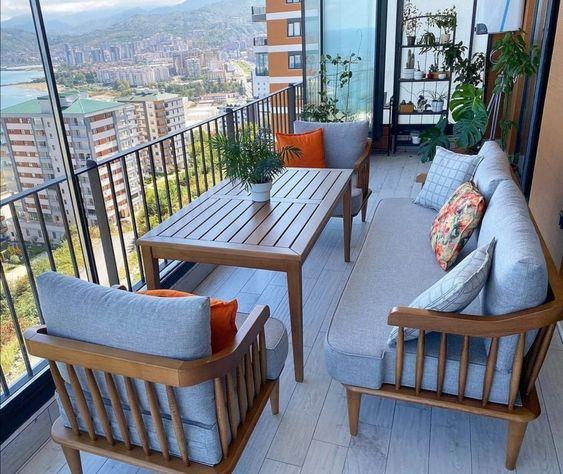 Compact Furniture
Compact Furniture
Image Source: Pinterest
Foldable Furniture:
- Space-Saving: Foldable chairs and tables are excellent for small balconies as they can be easily stored away when not in use, freeing up space for other activities like gardening or simply lounging.
- Portability: This furniture is also portable, allowing you to rearrange your balcony setup effortlessly. Look for weather-resistant materials to ensure longevity.
Multipurpose Pieces:
- Functionality: Multipurpose furniture, such as benches with storage, stools that double as tables, and corner sofas, can maximize your balcony's usability. These pieces provide seating while also offering storage solutions for gardening tools and supplies.
- Custom Designs: Consider custom-built furniture tailored to your balcony's specific dimensions. Built-in seating or custom shelves can make efficient use of awkward corners and maximize space.
Artificial Grass and Flooring
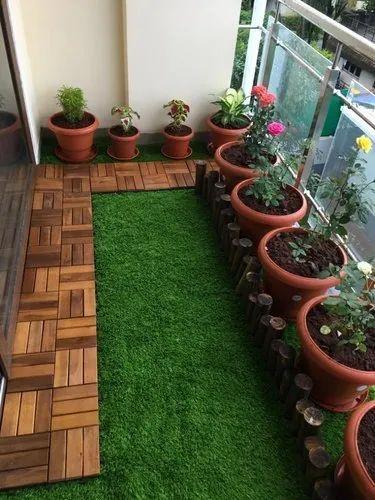 Artificial Grass and Flooring
Artificial Grass and Flooring
Image Source: Pinterest
Artificial Turf:
- Low Maintenance: Artificial turf is a great option for creating a garden-like feel without the maintenance associated with natural grass. It's soft underfoot, easy to clean, and can withstand various weather conditions.
- Visual Appeal: Adding artificial turf can make your balcony look vibrant and green year-round. It also provides a comfortable area for seating or for children and pets to play.
Wooden Deck Tiles:
- Natural Look: Wooden deck tiles are easy to install and maintain. They add a warm, natural look to your balcony, creating a cozy and inviting atmosphere.
- Installation: These tiles can be laid directly over existing balcony flooring, and they are available in various finishes and colors to suit different design preferences.
Balcony Garden Lights
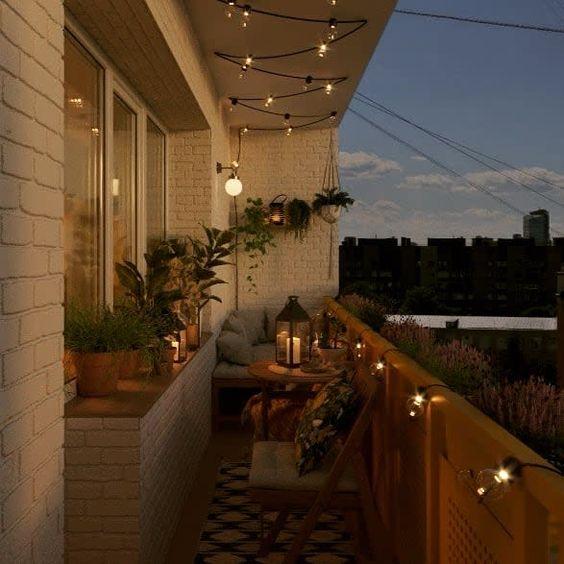 Balcony Garden Lights
Balcony Garden Lights
Image Source: Pinterest
Solar-Powered Lights:
- Eco-Friendly: Solar-powered lights are an eco-friendly and cost-effective lighting solution. They charge during the day and illuminate your balcony at night, creating a cozy ambiance.
- Versatility: These lights can be hung around the balcony, placed along railings, or staked into pots. They come in various styles, including fairy lights, lanterns, and pathway lights.
String Lights and Lanterns:
- Ambiance: String lights and lanterns add a magical touch to your balcony garden. They provide soft lighting that's perfect for evening relaxation or entertaining guests.
- Placement: Hang string lights along the balcony railing, across the ceiling, or wrap around plants and trellises. Lanterns can be placed on tables, hung from hooks, or used as floor decor.
Plant Selection
Selecting the right plants for your balcony garden is crucial to ensure they thrive in your specific conditions. Here's a detailed guide on various types of plants that you can choose based on their sunlight requirements and uses.
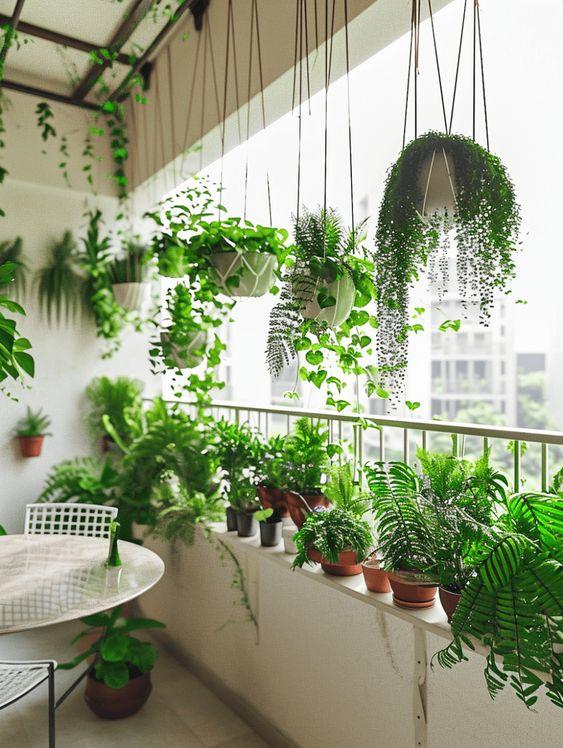 Plants in Balcony
Plants in Balcony
Image Source: Pinterest
Sun-Loving Plants
Bougainvillea, Hibiscus, and Marigolds:
- Bougainvillea: This vibrant, thorny vine is perfect for sunny balconies. It thrives in full sun and can be trained to climb trellises or cascade from hanging baskets. Bougainvillea adds a burst of color with its bright bracts in shades of pink, purple, orange, and red. It requires minimal watering once established, making it a low-maintenance option.
- Hibiscus: Known for its large, colorful flowers, hibiscus plants flourish in sunny conditions. They are available in a variety of colors, including red, yellow, pink, and white. Hibiscus plants not only add beauty to your balcony but also attract pollinators like butterflies and hummingbirds.
- Marigolds: These cheerful, easy-to-grow flowers are ideal for sunny spots. Marigolds come in vibrant shades of yellow, orange, and red. They are also known for their pest-repelling properties, making them a great companion plant for vegetables.
Vegetables and Herbs:
- Tomatoes: Tomatoes love sunlight and need at least six hours of direct sunlight daily. They can be grown in pots or hanging baskets. Choose compact or dwarf varieties like cherry tomatoes for balcony gardening.
- Chilies: Like tomatoes, chilies thrive in full sun and can be grown in containers. They come in various sizes and heat levels, allowing you to choose according to your preference.
- Basil: This aromatic herb requires plenty of sunlight to grow well. Basil is not only used in cooking but also acts as a natural insect repellent.
- Mint: Mint loves sunlight but can tolerate partial shade. It grows vigorously and is perfect for pots to prevent it from spreading uncontrollably.
Shade-Tolerant Plants
Ferns, Peace Lilies, and Philodendrons:
- Ferns: Ferns like the Boston fern and maidenhair fern thrive in shaded conditions. They require consistent moisture and add a lush, green look to your balcony.
- Peace Lilies: These plants are known for their white, sail-like flowers and glossy green leaves. Peace lilies do well in low light and can help improve indoor air quality.
- Philodendrons: These are versatile plants that can grow in various light conditions, including low light. They are easy to care for and come in both climbing and non-climbing varieties.
Medicinal Plants:
- Tulsi (Holy Basil): Tulsi is revered for its medicinal properties. It thrives in partial shade and requires regular watering. Tulsi is used in various home remedies for its anti-inflammatory and antioxidant properties.
- Aloe Vera: Aloe Vera is another shade-tolerant plant known for its medicinal uses. It requires minimal care and can be used for treating minor burns, skin irritations, and as a component in beauty routines.
Edible Plants
Herbs and Vegetables:
- Coriander (Cilantro): Coriander is a staple in cooking. It grows well in pots and requires moderate sunlight. Regular harvesting encourages bushy growth.
- Mint: As mentioned earlier, mint is a versatile herb that grows well in partial shade. It's widely used in cuisine and beverages.
- Curry Leaves: Curry leaf plants can be grown in pots and require partial sunlight. They are essential in South Indian cooking, adding a unique flavor to dishes.
- Ginger: Ginger can be grown in pots in shaded areas. It requires warm temperatures and regular watering. Fresh ginger harvested from your balcony garden can be used in cooking and home remedies.
Fruit Plants:
- Dwarf Citrus: Dwarf varieties of citrus trees, like lemons and oranges, can be grown in pots. They need plenty of sunlight and regular watering. These trees not only produce fresh fruits but also add a lovely fragrance to your balcony.
- Pomegranate: Dwarf pomegranate trees are perfect for container gardening. They thrive in sunny conditions and can produce small but flavorful fruits. Pomegranate plants also have ornamental value with their glossy leaves and bright flowers.
Creating a Comfortable Ambiance
Designing a comfortable and inviting ambiance on your balcony involves a thoughtful selection of seating, decor, lighting, and privacy solutions. Here's how you can achieve a cozy and aesthetically pleasing environment:
Seating and Decor
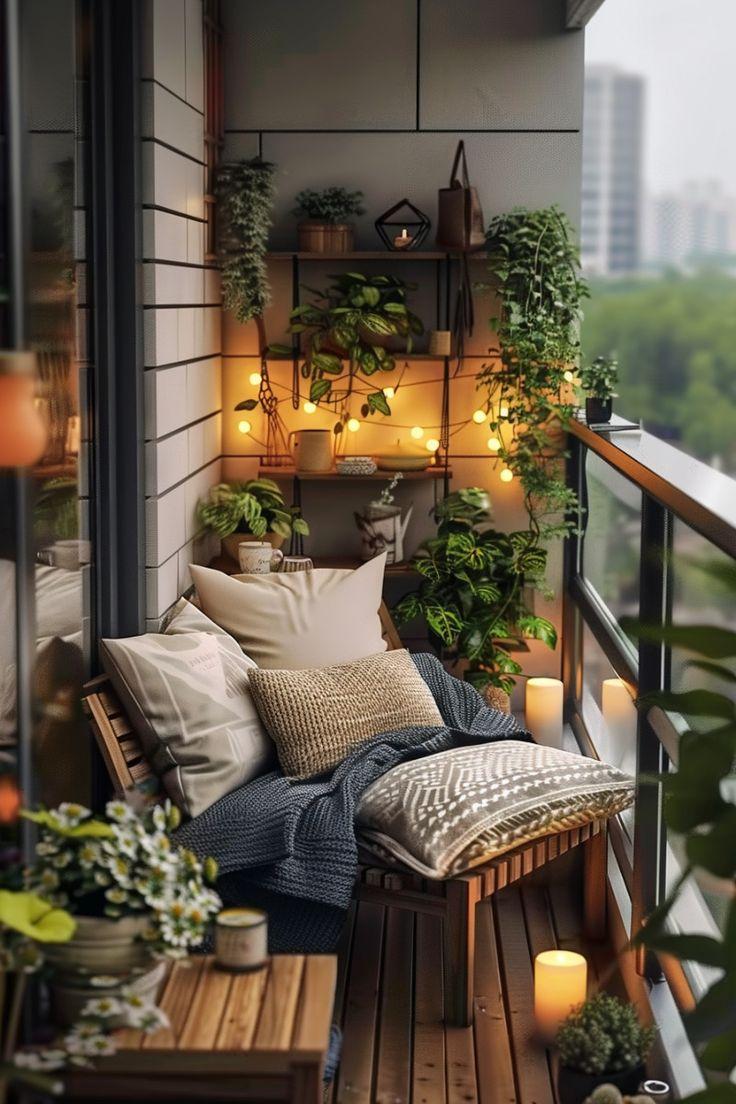 Seating and Decor
Seating and Decor
Image Source: Pinterest
Comfortable Seating:
- Weather-Resistant Cushions and Pillows: To ensure your balcony seating remains comfortable and durable, choose weather-resistant cushions and pillows. These materials are designed to withstand outdoor conditions, including sun and rain, ensuring longevity.
- Traditional Textiles and Patterns: Incorporate traditional textiles like block-printed fabrics, kantha quilts, or ikat cushions. These textiles not only add comfort but also infuse your balcony with rich cultural aesthetics. Patterns such as paisleys, floral motifs, and vibrant colors can make your space feel warm and inviting.
Decorative Elements:
- Clay Pots: Using clay pots for plants or as standalone decor items adds an earthy, rustic charm to your balcony. They are traditional, eco-friendly, and complement various plant types.
- Diyas and Lanterns: Diyas (traditional oil lamps) and lanterns can enhance the cultural ambiance. They are especially beautiful when lit in the evening, creating a serene and festive atmosphere.
- Small Statues: Incorporating small statues of deities, animals, or abstract art can add a personal touch to your balcony. Choose pieces that reflect your personality and cultural heritage.
Lighting
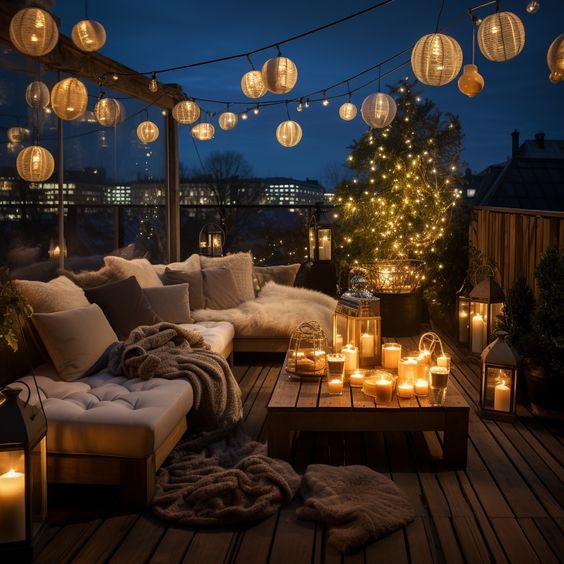 Lighting
Lighting
Image Source: Pinterest
Proper Lighting:
- Solar-Powered Lights: These are eco-friendly and cost-effective. They charge during the day and provide illumination at night, perfect for creating a sustainable lighting solution. Place them along railings, in plant beds, or hanging from above.
- String Lights: String lights can be draped along the balcony railing, hung overhead, or intertwined with plants and trellises. They offer soft, ambient lighting that creates a cozy and magical atmosphere.
- Lanterns: Decorative lanterns can be placed on tables, hung from hooks, or positioned on the floor. They come in various styles, from traditional brass to modern designs, and add both light and charm to your balcony.
Privacy Solutions
Bamboo Screens and Jute Curtains:
- Eco-Friendly Materials: Bamboo screens and jute curtains are sustainable choices that provide privacy while enhancing the natural aesthetic of your balcony. Bamboo screens can be placed along the sides of the balcony, creating a barrier from prying eyes while adding a tropical feel.
- Jute Curtains: These curtains are lightweight, breathable, and offer a rustic look. They can be easily drawn to provide privacy and shade when needed and pulled back to allow light and airflow.
Tall Plants and Trellises:
- Natural Screens: Using tall plants such as bamboo, palms, or tall grasses can create a natural screen that adds to the greenery and privacy of your balcony. These plants not only provide a visual barrier but also contribute to a serene, garden-like atmosphere.
- Trellises: Install trellises along the sides of your balcony to support climbing plants like ivy, jasmine, or bougainvillea. These plants grow densely and can form an effective natural screen. Trellises add vertical interest and enhance the overall greenery of your balcony garden.
Maintenance Tips
Maintaining a balcony garden involves regular care and attention to ensure plants thrive in their urban environment. Here are some detailed maintenance tips focusing on watering, pest control, and preparing for the monsoon season.
Watering
Regular Watering:
- Timing: Watering plants early in the morning or late in the evening helps prevent rapid evaporation and ensures that plants stay hydrated. During these times, the temperatures are cooler, allowing the soil to absorb water more effectively. This practice also helps reduce the risk of fungal diseases that can occur when plants remain wet overnight.
- Consistency: Establish a regular watering schedule based on the needs of your plants. Most plants require consistent moisture, but it's essential to avoid overwatering, which can lead to root rot.
Drip Irrigation Systems:
- Installation: A drip irrigation system can be an excellent investment for your balcony garden. These systems deliver water directly to the plant roots, minimizing water wastage and ensuring consistent hydration. They are especially useful for busy urban gardeners who might not have time for daily watering.
- Benefits: Drip irrigation reduces the risk of overwatering and underwatering, promoting healthier plant growth. It also helps maintain the soil's nutrient balance, as the water is delivered slowly and directly to the roots.
Pest Control
Natural Remedies:
- Neem Oil: Neem oil is a natural pesticide that is effective against a wide range of garden pests. It is safe for plants and can be used to control aphids, whiteflies, spider mites, and more. Mix neem oil with water and a few drops of mild soap, then spray it on affected plants.
- Companion Planting: Companion planting involves growing certain plants together to naturally repel pests. For example, marigolds can deter nematodes, while basil repels aphids and mosquitoes. Integrating such plants into your balcony garden can help manage pest populations organically.
- Regular Inspection: Regularly inspect your plants for signs of pests, such as chewed leaves, discolored foliage, or visible insects. Early detection allows for prompt action, preventing pest infestations from spreading.
Monsoon Preparation:
- Good Drainage: Ensure that your pots and containers have adequate drainage to prevent waterlogging, which can damage plant roots. Use pots with drainage holes and consider adding a layer of gravel or broken pottery at the bottom to improve drainage.
- Sheltered Areas: During heavy rains, move sensitive plants to sheltered areas to protect them from excessive water and strong winds. You can place them under eaves, awnings, or inside temporarily.
- Windbreaks: Use windbreaks such as mesh screens or taller plants to shield delicate plants from strong monsoon winds. This protection helps prevent damage to foliage and supports the overall health of your balcony garden.
Enhancing the Experience
Creating a balcony garden isn't just about the plants; it's also about making the space a place where you can relax and unwind. Here are some detailed ideas on enhancing the experience of your balcony garden.
Reading Nook
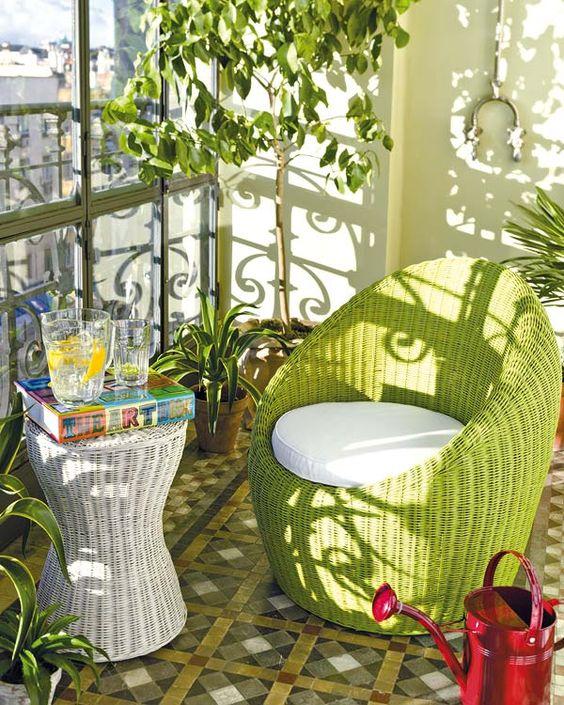 Reading Nook
Reading Nook
Image Source: Pinterest
Cozy Corner:
- Comfortable Chair: Choose a comfortable chair that fits well in your balcony space. Consider a rocking chair, a cushioned armchair, or even a hammock chair if your balcony has the structural support.
- Small Table: A small table is essential for holding books, a cup of tea, or other essentials. Opt for a foldable table if space is limited.
- Cushions and Blankets: Adding cushions and a blanket can make your reading nook cozy and inviting. Use weather-resistant fabrics to ensure durability. Incorporate patterns and textures that complement the overall decor of your balcony.
Minimalist Approach
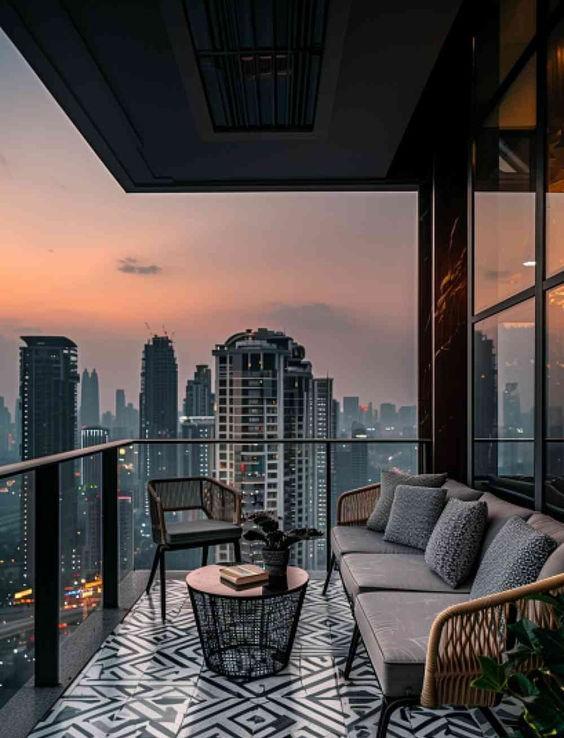 Minimalist Balcony
Minimalist Balcony
Image Source: Pinterest
Clutter-Free Space:
- Avoid Overcrowding: Keep the balcony clutter-free by avoiding too many decorative elements. This approach not only makes the space look more extensive but also allows for easier maintenance.
- One or Two Focal Points: Select one or two main focal points, such as a striking plant, a piece of art, or a statement furniture piece. This minimalist design helps create a serene and organized space.
Creative Use of Patterns and Colors
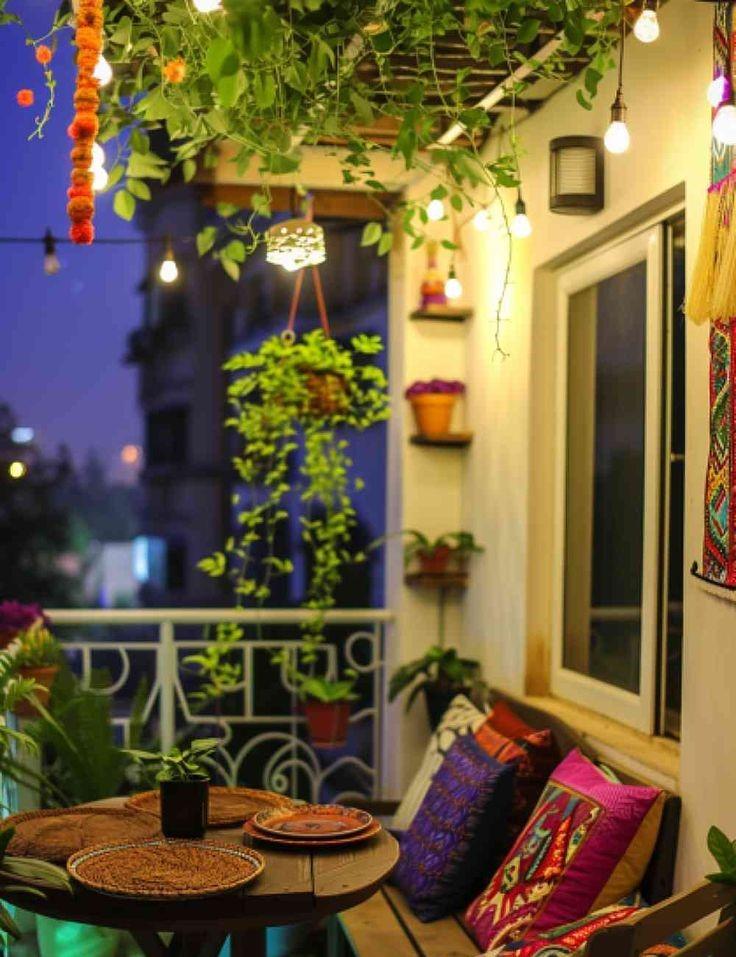 Creative use of patterns and colors
Creative use of patterns and colors
Image Source: Pinterest
Patterns:
- Patterned Cushions, Rugs, and Pots: Introduce patterns through cushions, rugs, and pots. Traditional patterns like ikat, block prints, or paisleys can add a cultural touch and visual interest.
- Mix and Match: Experiment with different patterns and textures to create a unique and vibrant look. Don't be afraid to mix florals with geometrics or stripes with solids.
Colors:
- Bold Colors: Bright colors like blues, reds, and yellows can make your balcony stand out and feel lively. Use these colors in cushions, planters, and other decorative elements.
- Accent Colors: Choose a primary color and use it consistently as an accent throughout your balcony decor. This approach ties everything together and creates a cohesive look.
DIY Projects
Wood Pallet Furniture:
- Creating Furniture: Use wood pallets to create DIY furniture pieces like tables, benches, or plant stands. Pallets are affordable and versatile, allowing for customization to fit your balcony's size and style.
- Sustainability: Using reclaimed pallets is an eco-friendly option. Sand and paint them to suit your decor or leave them natural for a rustic look.
Custom-Built Furniture:
- Tailor-Made: Custom-built furniture can maximize space and functionality. Consider pieces that fit perfectly into your balcony's dimensions and meet your specific needs.
- Foldable or Stackable: Furniture that can be folded or stacked when not in use is ideal for small spaces. This flexibility allows you to transform the balcony for different uses.
Utilizing Railing Space
Breakfast Bar:
- Premade or DIY: Turn your balcony railing into a breakfast bar by attaching a premade table or creating one using plywood. Ensure it's securely fastened to the railing for safety.
- Bistro Stools: Add bistro stools to complete the look. Choose stools that can withstand outdoor conditions and that are the right height for your bar.
Conclusion
Creating a small balcony garden in a city apartment is a rewarding endeavor that brings numerous benefits to urban living. These green sanctuaries not only enhance the aesthetic appeal of your home but also provide a personal retreat where you can relax and unwind. By carefully evaluating your space and its unique conditions, thoughtfully designing the layout, selecting suitable plants, and incorporating functional and decorative elements, you can transform even the smallest balcony into a vibrant, functional, and relaxing green oasis.
Balcony gardens allow you to practice sustainable living by using eco-friendly materials and growing your herbs and vegetables. They offer a sense of accomplishment and peace, making gardening a therapeutic activity that connects you with nature amidst the urban hustle. Whether you prefer a minimalist setup or a lush, colorful space, your balcony garden can be a true reflection of your personality and style, providing a serene escape right at your doorstep.
With proper maintenance, from watering and pest control to preparing for seasonal changes, your balcony garden will thrive year-round, adding value to your apartment and enhancing your quality of life. Embrace the joy of gardening and create a beautiful, green retreat that you can enjoy every day.
explore further
Latest from Contemporary ideas
More from Innovations
Resources
Dwello, for every home buyer, is a way to go from 'I feel' to 'I know', at no extra cost.




